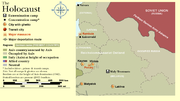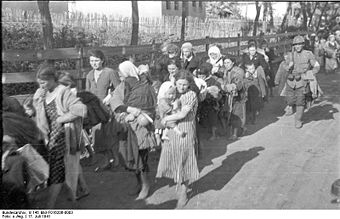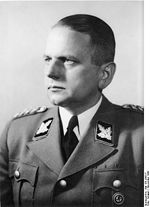
The Holocaust in the USSR
Encyclopedia


Genocide
Genocide is defined as "the deliberate and systematic destruction, in whole or in part, of an ethnic, racial, religious, or national group", though what constitutes enough of a "part" to qualify as genocide has been subject to much debate by legal scholars...
of Jews
Jews
The Jews , also known as the Jewish people, are a nation and ethnoreligious group originating in the Israelites or Hebrews of the Ancient Near East. The Jewish ethnicity, nationality, and religion are strongly interrelated, as Judaism is the traditional faith of the Jewish nation...
during the occupation of the USSR by Nazi Germany
Nazi Germany
Nazi Germany , also known as the Third Reich , but officially called German Reich from 1933 to 1943 and Greater German Reich from 26 June 1943 onward, is the name commonly used to refer to the state of Germany from 1933 to 1945, when it was a totalitarian dictatorship ruled by...
.
On the eve of the Holocaust
Beyond longstanding controversies, ranging from the Molotov-Ribbentrop PactMolotov-Ribbentrop Pact
The Molotov–Ribbentrop Pact, named after the Soviet foreign minister Vyacheslav Molotov and the German foreign minister Joachim von Ribbentrop, was an agreement officially titled the Treaty of Non-Aggression between Germany and the Soviet Union and signed in Moscow in the late hours of 23 August 1939...
to anti-Zionism
Anti-Zionism
Anti-Zionism is opposition to Zionistic views or opposition to the state of Israel. The term is used to describe various religious, moral and political points of view in opposition to these, but their diversity of motivation and expression is sufficiently different that "anti-Zionism" cannot be...
, the Soviet Union
Soviet Union
The Soviet Union , officially the Union of Soviet Socialist Republics , was a constitutionally socialist state that existed in Eurasia between 1922 and 1991....
did grant official "equality of all citizens regardless of status
Social status
In sociology or anthropology, social status is the honor or prestige attached to one's position in society . It may also refer to a rank or position that one holds in a group, for example son or daughter, playmate, pupil, etc....
, sex, race, religion, and nationality." The years before the Holocaust
The Holocaust
The Holocaust , also known as the Shoah , was the genocide of approximately six million European Jews and millions of others during World War II, a programme of systematic state-sponsored murder by Nazi...
were an era of rapid change for Soviet Jews, leaving behind the dreadful poverty of the Pale of Settlement
Pale of Settlement
The Pale of Settlement was the term given to a region of Imperial Russia, in which permanent residency by Jews was allowed, and beyond which Jewish permanent residency was generally prohibited...
. 40% of the population in the former Pale left for large cities within the USSR. Emphasis on education and movement from countryside shtetl
Shtetl
A shtetl was typically a small town with a large Jewish population in Central and Eastern Europe until The Holocaust. Shtetls were mainly found in the areas which constituted the 19th century Pale of Settlement in the Russian Empire, the Congress Kingdom of Poland, Galicia and Romania...
s to newly industrialized cities allowed many Soviet Jews to enjoy overall advances under Joseph Stalin
Joseph Stalin
Joseph Vissarionovich Stalin was the Premier of the Soviet Union from 6 May 1941 to 5 March 1953. He was among the Bolshevik revolutionaries who brought about the October Revolution and had held the position of first General Secretary of the Communist Party of the Soviet Union's Central Committee...
and to become one of the most educated population groups in the world. Due to Stalinist emphasis on its urban population, interwar migration inadvertently rescued countless Soviet Jews; Nazi Germany
Nazi Germany
Nazi Germany , also known as the Third Reich , but officially called German Reich from 1933 to 1943 and Greater German Reich from 26 June 1943 onward, is the name commonly used to refer to the state of Germany from 1933 to 1945, when it was a totalitarian dictatorship ruled by...
penetrated the entire former Jewish Pale — but were kilometers short of Leningrad
Saint Petersburg
Saint Petersburg is a city and a federal subject of Russia located on the Neva River at the head of the Gulf of Finland on the Baltic Sea...
and Moscow
Moscow
Moscow is the capital, the most populous city, and the most populous federal subject of Russia. The city is a major political, economic, cultural, scientific, religious, financial, educational, and transportation centre of Russia and the continent...
.
The great wave of deportations from the areas annexed by Soviet Union according to the Nazi-Soviet pact, often seen by victims as genocide, paradoxically also saved lives of a few hundred thousand Jewish deportees. However horrible their conditions, the fate of Jews in Nazi Germany was much worse. The migration of many Jews deeper East from the part of the Jewish Pale that would become occupied by Germany saved at least forty percent of this area's Jewish population.
World War II
On 22 June 1941, Adolf HitlerAdolf Hitler
Adolf Hitler was an Austrian-born German politician and the leader of the National Socialist German Workers Party , commonly referred to as the Nazi Party). He was Chancellor of Germany from 1933 to 1945, and head of state from 1934 to 1945...
abruptly broke the non−aggression pact and invaded the Soviet Union
Operation Barbarossa
Operation Barbarossa was the code name for Germany's invasion of the Soviet Union during World War II that began on 22 June 1941. Over 4.5 million troops of the Axis powers invaded the USSR along a front., the largest invasion in the history of warfare...
. The Soviet territories occupied by early 1942, including all of Belarus, Estonia, Latvia, Lithuania, Ukraine, and Moldova
Moldova
Moldova , officially the Republic of Moldova is a landlocked state in Eastern Europe, located between Romania to the West and Ukraine to the North, East and South. It declared itself an independent state with the same boundaries as the preceding Moldavian Soviet Socialist Republic in 1991, as part...
and most Russian territory west of the line Leningrad
Leningrad
Leningrad is the former name of Saint Petersburg, Russia.Leningrad may also refer to:- Places :* Leningrad Oblast, a federal subject of Russia, around Saint Petersburg* Leningrad, Tajikistan, capital of Muminobod district in Khatlon Province...
-Moscow-Rostov
Rostov
Rostov is a town in Yaroslavl Oblast, Russia, one of the oldest in the country and a tourist center of the Golden Ring. It is located on the shores of Lake Nero, northeast of Moscow. Population:...
, contained about 4 million Jews, including hundreds of thousands who had fled Poland in 1939. Despite the chaos of the Soviet retreat, some effort was made to evacuate Jews, who were either employed in the military industries of were family members of servicemen. Of 4 million about a million succeeded in escaping further east. The remaining 3 million were left at the mercy of the Nazis.
Despite the subservience of the Oberkommando des Heeres
Oberkommando des Heeres
The Oberkommando des Heeres was Nazi Germany's High Command of the Army from 1936 to 1945. The Oberkommando der Wehrmacht commanded OKH only in theory...
to Adolf Hitler, Heinrich Himmler
Heinrich Himmler
Heinrich Luitpold Himmler was Reichsführer of the SS, a military commander, and a leading member of the Nazi Party. As Chief of the German Police and the Minister of the Interior from 1943, Himmler oversaw all internal and external police and security forces, including the Gestapo...
did not trust the Army to approve of, let alone carry out, the large-scale killings of Jews in the occupied Soviet territories. This task was assigned to SS formations called Einsatzgruppen
Einsatzgruppen
Einsatzgruppen were SS paramilitary death squads that were responsible for mass killings, typically by shooting, of Jews in particular, but also significant numbers of other population groups and political categories...
("task groups"), under the overall command of Reinhard Heydrich
Reinhard Heydrich
Reinhard Tristan Eugen Heydrich , also known as The Hangman, was a high-ranking German Nazi official.He was SS-Obergruppenführer and General der Polizei, chief of the Reich Main Security Office and Stellvertretender Reichsprotektor of Bohemia and Moravia...
. These had been used on a limited scale in Poland in 1939, but were now organized on a much larger scale. According to Otto Ohlendorf
Otto Ohlendorf
Otto Ohlendorf was a German SS-Gruppenführer and head of the Inland-SD , a section of the SD. Ohlendorf was the commanding officer of Einsatzgruppe D, which conducted mass murder in Moldova, south Ukraine, the Crimea, and, during 1942, the north Caucasus...
at his trial
Einsatzgruppen Trial
The Einsatzgruppen Trial was the ninth of the twelve trials for war crimes the U.S. authorities held in their occupation zone in Germany in Nuremberg after the end of World War II. These twelve trials were all held before U.S...
, "the Einsatzgruppen had the mission to protect the rear of the troops by killing the Jews, gypsies, Communist functionaries, active Communists, and all persons who would endanger the security." In practice, their victims were nearly all defenseless Jewish civilians (not a single Einsatzgruppe member was killed in action during these operations).
Raul Hilberg
Raul Hilberg
Raul Hilberg was an Austrian-born American political scientist and historian. He was widely considered to be the world's preeminent scholar of the Holocaust, and his three-volume, 1,273-page magnum opus, The Destruction of the European Jews, is regarded as a seminal study of the Nazi Final...
writes that the Einsatzgruppe member were ordinary citizens; the great majority were university-educated professionals. They used their skills to become efficient killers, according to Michael Berenbaum
Michael Berenbaum
Michael Berenbaum is an American scholar, professor, rabbi, writer, and film-maker, who specializes in the study of the memorialization of the Holocaust...
.
By the end of 1941, however, the Einsatzgruppen had killed only 15 percent of the Jews in the occupied Soviet territories, and it was apparent that these methods could not be used to kill all the Jews of Europe. Even before the invasion of the Soviet Union, experiments with killing Jews in the back of vans using gas from the van's exhaust had been carried out
Gas van
The gas van or gas wagon was an extermination method devised by Nazi Germany to kill victims of the regime. It was also rumored that analog of such device was used by the Soviet Union on an experimental basis during the Great Purge-Nazi Germany:...
, and when this proved too slow, more lethal gasses were tried. For large-scale killing by gas, however, fixed sites would be needed, and it was decided—probably by Heydrich and Eichmann—that the Jews should be brought to camps specifically built for the purpose.
The Nazi Genocide of the Jews
The Holocaust
The Holocaust , also known as the Shoah , was the genocide of approximately six million European Jews and millions of others during World War II, a programme of systematic state-sponsored murder by Nazi...
carried by German Einsatzgruppen
Einsatzgruppen
Einsatzgruppen were SS paramilitary death squads that were responsible for mass killings, typically by shooting, of Jews in particular, but also significant numbers of other population groups and political categories...
, along the local collaborators resulted in almost complete annihilation of the Jewish population over the entire territory temporary occupied by Germany and its allies.
In October 1943, 600 Jewish and Russian prisoners attempted an escape at the Sobibór extermination camp
Sobibór extermination camp
Sobibor was a Nazi German extermination camp located on the outskirts of the town of Sobibór, Lublin Voivodeship of occupied Poland as part of Operation Reinhard; the official German name was SS-Sonderkommando Sobibor...
. About 60 survived and joined the Belarusian partisans
Belarusian partisans
Belarusian partisans were fighters in irregular military groups participating in the Belarusian resistance movement, including against Nazi Germany and collaborationism during World War II.- World War II :...
. In Eastern Europe
Eastern Europe
Eastern Europe is the eastern part of Europe. The term has widely disparate geopolitical, geographical, cultural and socioeconomic readings, which makes it highly context-dependent and even volatile, and there are "almost as many definitions of Eastern Europe as there are scholars of the region"...
, many Jews joined the ranks of the Soviet partisans
Soviet partisans
The Soviet partisans were members of a resistance movement which fought a guerrilla war against the Axis occupation of the Soviet Union during World War II....
: throughout the war, they faced antisemitism and discrimination from the Soviets and some Jewish partisans were killed, but over time, many of the Jewish partisan groups were absorbed into the command structure of the much larger Soviet partisan movement. Soviet partisans were not in a position to ensure protection to the Jews in the Holocaust
The Holocaust
The Holocaust , also known as the Shoah , was the genocide of approximately six million European Jews and millions of others during World War II, a programme of systematic state-sponsored murder by Nazi...
. The fit Jews were usually welcomed by the partisans (sometimes only if they brought their own weapons); however women, children, and the elderly were mostly unwelcome. Eventually, however, separate Jewish groups, both guerrilla units and mixed family groups of refugee
Refugee
A refugee is a person who outside her country of origin or habitual residence because she has suffered persecution on account of race, religion, nationality, political opinion, or because she is a member of a persecuted 'social group'. Such a person may be referred to as an 'asylum seeker' until...
s (like the Bielski partisans
Bielski partisans
The Bielski partisans were an organisation of Jewish partisans who rescued Jews from extermination and fought against the Nazi German occupiers and their collaborators in the vicinity of Nowogródek and Lida in German-occupied Poland...
), were subordinated to the communist partisan leadership and considered as Soviet assets.
It is estimated that up to 1.4 million Jews fought in Allied
Allies of World War II
The Allies of World War II were the countries that opposed the Axis powers during the Second World War . Former Axis states contributing to the Allied victory are not considered Allied states...
armies; 40% of them in the Red Army
Red Army
The Workers' and Peasants' Red Army started out as the Soviet Union's revolutionary communist combat groups during the Russian Civil War of 1918-1922. It grew into the national army of the Soviet Union. By the 1930s the Red Army was among the largest armies in history.The "Red Army" name refers to...
. In total, at least 142 500 Soviet soldiers of Jewish nationality lost their lives fighting against the German invadors and their allies
Even as some assisted the Germans, a significant number of individuals in the territories under German control also helped Jews escape death (see Righteous Among the Nations
Righteous Among the Nations
Righteous among the Nations of the world's nations"), also translated as Righteous Gentiles is an honorific used by the State of Israel to describe non-Jews who risked their lives during the Holocaust to save Jews from extermination by the Nazis....
).
Executors

- SS-Gruppenführer Otto OhlendorfOtto OhlendorfOtto Ohlendorf was a German SS-Gruppenführer and head of the Inland-SD , a section of the SD. Ohlendorf was the commanding officer of Einsatzgruppe D, which conducted mass murder in Moldova, south Ukraine, the Crimea, and, during 1942, the north Caucasus...
- SS-Gruppenführer und Generalleutnant der Waffen-SS und Polizei Walter SchimanaWalter SchimanaWalter Schimana was a German Nazi Party and SS member, who rose to General rank during World War II, and was HSSPF in occupied Greece from October 1943.- Early life :Schimana was born in Troppau, then part of Austria-Hungary, the son of a newspaper editor...
Executor units
- Schutzmannschaft-Brigade SieglingSchutzmannschaft-Brigade SieglingSchutzmannschaft-Brigade Siegling - was a Nazi German auxiliary police brigade formed by 31 July 1944 at East Prussia from the retreated from Belarus dozen remnants of the SiPo, SD, Ordnungsdienst units, Kommandanturas personnel and BKA units composed from the Ukrainians, Belarusians,...
- EinsatzgruppenEinsatzgruppenEinsatzgruppen were SS paramilitary death squads that were responsible for mass killings, typically by shooting, of Jews in particular, but also significant numbers of other population groups and political categories...
(EinsatzkommandoEinsatzkommandoDuring World War II, the Nazi German Einsatzkommandos were a sub-group of five Einsatzgruppen mobile killing squads—up to 3,000 men each—usually composed of 500-1,000 functionaries of the SS and Gestapo, whose mission was to kill Jews, Romani, communists and the NKVD collaborators in the captured...
)
See also
- The Holocaust in Russia
- International Conference to Review the Global Vision of the HolocaustInternational Conference to Review the Global Vision of the HolocaustThe International Conference to Review the Global Vision of the Holocaust was a two-day conference that opened on December 11, 2006, in Tehran, Iran. Iranian Foreign Minister Manouchehr Mottaki said the conference sought "neither to deny nor prove the Holocaust.....
- List of murders of children by Nazis
- Russian Research and Educational Holocaust CenterRussian Research and Educational Holocaust CenterThe Russian Research and Educational Holocaust Center was founded in 1992 in Moscow and has since then been working on awareness raising of the Holocaust in the Russian society...

